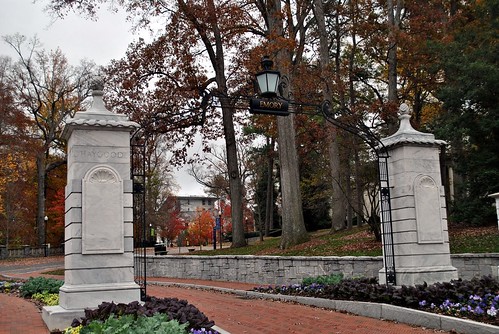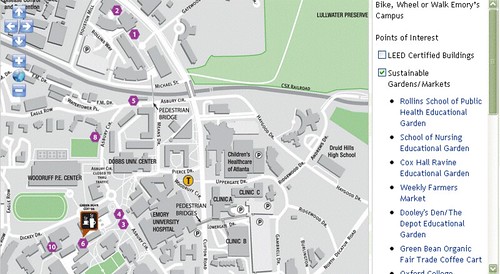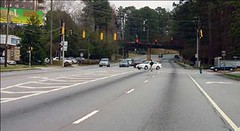Emory University's impressive commitment to sustainability

Posted April 4, 2011 at 2:02PM
I can’t claim to have reviewed them all, but the sustainability initiative at Emory University has to be one of the nation’s most comprehensive and accomplished. (As an alumnus (BA, history), I couldn’t be more pleased to have discovered it.)
The rich history of the university’s modern green efforts dates back at least a couple of decades, but one of the key events occurred in 1999 with the formation of an Ad Hoc Committee on Environmental Stewardship, initially formed to discuss a controversial proposal for a new road through a forested and much-loved area of the campus. The group of 20 to 30 faculty, staff, administrators, students, and alumni soon took on a broader purpose, meeting monthly for three years to educate themselves about campus issues and to take action in several directions.
 In 2000, the committee began to create an environmental mission statement for the university. According to the sustainability initiative’s web site, “committee members studied other schools' documents and met with 22 campus divisions and groups, including the Employee Council, the Libraries, Purchasing, Emory Dining, faculty from different units, and student groups. The final consensus wording was adopted by the University Senate and approved by the President in March 2001.”
In 2000, the committee began to create an environmental mission statement for the university. According to the sustainability initiative’s web site, “committee members studied other schools' documents and met with 22 campus divisions and groups, including the Employee Council, the Libraries, Purchasing, Emory Dining, faculty from different units, and student groups. The final consensus wording was adopted by the University Senate and approved by the President in March 2001.”
From the mission statement:
“We, the Emory University community, affirm our commitment to protect and enhance the environment through our teaching, research, service, and administrative operations. We seek to foster a community that sustains ecological systems and educates for environmental awareness, local action, and global thinking. We seek to make environmentally sound practices a core value of the University. Our fundamental principles are to:
- Incorporate environmental concerns as a significant priority in university decision making.
Seek alternative practices and procedures to minimize negative impacts on the environment.
- Conserve natural resources and restore environmental quality.
- Protect the biodiversity of our region and serve as a living library and habitat for local species.
- Consider the social and economic impacts of Emory’s environmental policies and foster a participatory process in developing these policies.”
As with all mission statements, the wording was broad. But implementation began immediately, and the initiative soon became more specific. In 2006, after “a vigorous strategic planning process” for the institution as a whole that had begun two years earlier, the university adopted sustainability as a “core commitment” and adopted a detailed vision to establish Emory as “a global model” of green practices. The vision is packed with specifics, including commitments to reduce building energy use per square foot by 25 percent, 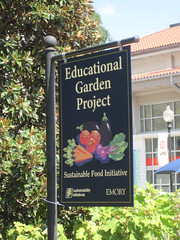 and reduce waste by 65 percent, by 2015.
and reduce waste by 65 percent, by 2015.
Today, the sustainability initiative’s web site lists activities and accomplishments in nine categories, which are reinforced throughout the site:
- Green buildings and green space
- Sustainable food
- Water conservation
- Energy awareness
- Recycling and re-use
- Commute alternatives
- Emory as place
- Curriculum and research
- Climate action
You can go to the “dashboard” section of the site and view particular initiatives and find statistics in most categories, such as land classification by year, sustainable food purchases by year, 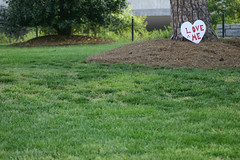 energy use by year and by building type, greenhouse gas emissions by year, and so on.
energy use by year and by building type, greenhouse gas emissions by year, and so on.
For example, if you follow the link to “tree canopy by year,” you will learn that in 1999 the school adopted a policy of “no net loss” of canopy and that, in fact, the acreage of tree canopy has been increasing slightly in recent years. Follow another link and you can learn that the university tracks greenhouse gas emissions from fuels used in campus facilities, to power plant emissions from electricity consumed, to indirect activities “such as miles flown or driven for business or athletic events and the decomposition of our trash that is sent to landfills.” Overall greenhouse gas emissions have been going down somewhat in recent years, no doubt because the university has reduced its building energy consumption per square foot by 15 percent since 2005.
As for the curriculum, I am particularly intrigued by the description of a class called Emory as Place, offered as part of a course in Religion and Ecology, which “explores the ecosystems of Georgia through environmental analyses and contemplative traditions of Christianity and Buddhism.”
Being both familiar with the campus and a major fan of maps, I spent quite a bit of time on the interactive sustainability map which allows you to check options and see, for example, the locations (in dark green, above) of 18 of the university’s LEED-certified buildings or follow the red line, which will guide you on a walking tour of ten of them. On the right you can click on any one, as I did for the Candler Library, where I practically lived during my time on campus, and learn more:
“Candler Library's renovation and expansion is a wonderful example of an historically important building attaining LEED silver certification. The renovation added new low-flow aerators to water fixtures to reduce water usage and new insulation, building automation, control devices and occupancy sensors to conserve energy.”
The second map shown (of twelve in all) indicates (in purple) the locations of eleven sustainable gardens or markets, including at the old train depot on campus:
“Located in the front of Dooley’s Depot, this garden is one of eight educational gardens that are maintained by a team of staff, students, neighbors and faculty. The harvests, which boast tomatoes, lettuces, peas, beans, greens, eggplant, broccoli, strawberries and even cotton, are shared within each team of harvesters. The food gardens exist to increase awareness of and interest in local food and educate the Emory community about what food crops look like, seasonality and how they grow.”
(The depot actually operated as such back in the day. 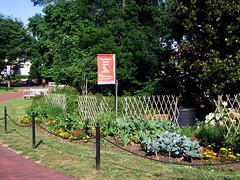 I took a train to see James Brown himself in Athens, but that’s another story altogether.)
I took a train to see James Brown himself in Athens, but that’s another story altogether.)
Reflecting one of the pledges in the 2006 vision to engage the world outside the university campus on sustainability issues, Emory worked with its surrounding neighborhoods to form the Clifton Community Partnership. My friends Mary Means and David Dixon have been central to the community engagement, planning and architecture issues at the heart of the partnership’s agenda, which aspires to achieve the following:
“In 10 years, students, faculty staff, patients (at Emory Hospital, on Clifton Road), residents and visitors will know they are in the Clifton community by the
- progressive urban design,
- beautifully landscaped streetscapes,
- walkable safe sidewalks,
- range of activities offered in the area and
- the confluence of people actively engaged in the community.”
Emory's campus is just within the city limits of Atlanta, in an area that feels much like an inner-ring suburb. Two years ago, David’s firm produced over 200 pages of illustrated design guidelines for the Partnership to “create places of greater civic value, promote environmental sustainability, expand choices, improve accessibility and connectivity, enhance personal well-being [and] foster community-wide engagement.” I’ll take that. The guidelines are probably worth their own blog post at some point.
YouTube has several videos related to Emory’s sustainability initiatives, including one on the university’s bike commuting program and another on the campus’s fabulous Lullwater nature preserve. This one, which is very nicely produced, gives an overview of the school’s impressive approach:
Move your cursor over the images for credit information.
